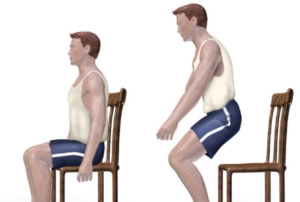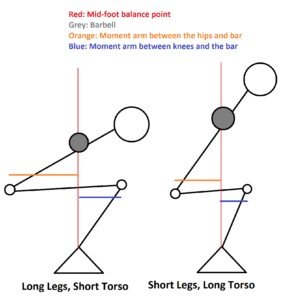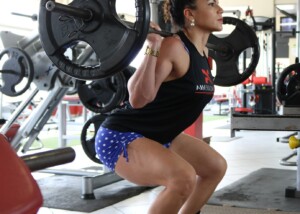
I could not believe it when a strength training enthusiast chastised another about the parallel squat, in that the one trainee insisted he was not able to squat due to a short torso (and long femurs).
The critical person said, “If you can get up and down from a chair and toilet, you can do a parallel squat, so stop making excuses!”
People with short torsos and long femurs can get into a parallel squat. Few people will deny this.
However, the position your body takes, when sitting onto a toilet and then rising, is not the recommended or same position that one should perform a barbell squat with!
Using a toilet involves crouching forward, supporting oneself with the forearms on the thighs! Who sits upright, arms off thighs, with a lower back arch while on a toilet?
And what fitness expert or even experienced trainee would recommend barbell squatting with a crouched forward torso?
The crouched forward torso makes it easy as pie to rise from a toilet!
As for lowering and rising from a chair, this comparison to the parallel squat is deeply flawed because the chair prevents a person from falling backwards onto the floor!
Who squats parallel with a barbell or even bodyweight only, with their legs, feet and back positioned as they are when getting into and out of a standard chair?
Last time I checked, not a single human being on this planet. It is physically impossible.
Getting into and out of a chair does not require the ankle dorsiflexion that a parallel squat does.
The chair provides external support, too. In a parallel squat for exercise, nothing supports the trainee!
Of Short Torsos and Long Femurs…
Though a chair is an excellent training tool for developing a parallel squat for those with short torsos and long femurs, getting into and out of a chair in daily life is an extremely poor analogy to the parallel squat!
Those with short torsos and long femurs can hover over a chair and practice the lower back arch and minimizing the forward torso lean, and experiment with dorsiflexion while viewing their profile in a mirror.
To say that getting into and out of a chair or onto and off a toilet means that you can parallel squat, means that your 87-year-old Grandma can parallel squat because she can lower and rise from a dining room chair and get onto and off a toilet without assistance!
Can you picture Grandma squatting to parallel without holding onto anything, let alone with a barbell across her back?
The muscular forces and leverages that a parallel squat requires are NOT required to lower into a chair and then stand up from it.
This is why when a person lowers into a chair and a sneaky person pulls the chair out from under them, they fall flat on their can instead of remaining suspended in the air in a parallel squat position, even when they know what just happened!
I said earlier that those with short torsos and long femurs can get into a parallel squat.
BUT — the problem is, if their femur, shin bone and torso ratios are disadvantaged enough, they will need to execute a severe forward torso lean, making the lower back arch impossible.

Their back is rounded, chest smack on top of their thighs (think of a closed clam shell or a speed skater cruising in a distance race).
Often, to hold even THIS position, those with short torsos and long femurs must have their arms straight out in front of them.
So how is it possible for these trainees to execute a parallel squat with their back erect enough to support a barbell without rounding their back?
Those with short torsos and long femurs can have all the ankle, hip and low back flexibility in the world, and still find it impossible to avoid the rounded, slumped-over back while going parallel.
Their only recourse is to Sumo their stance or elevate their heels, best done with shoe lifts, which are significantly cheaper than weightlifting shoes.
 Lorra Garrick is a former personal trainer certified through the American Council on Exercise. At Bally Total Fitness she trained women and men of all ages for fat loss, muscle building, fitness and improved health.
Lorra Garrick is a former personal trainer certified through the American Council on Exercise. At Bally Total Fitness she trained women and men of all ages for fat loss, muscle building, fitness and improved health.
.









































